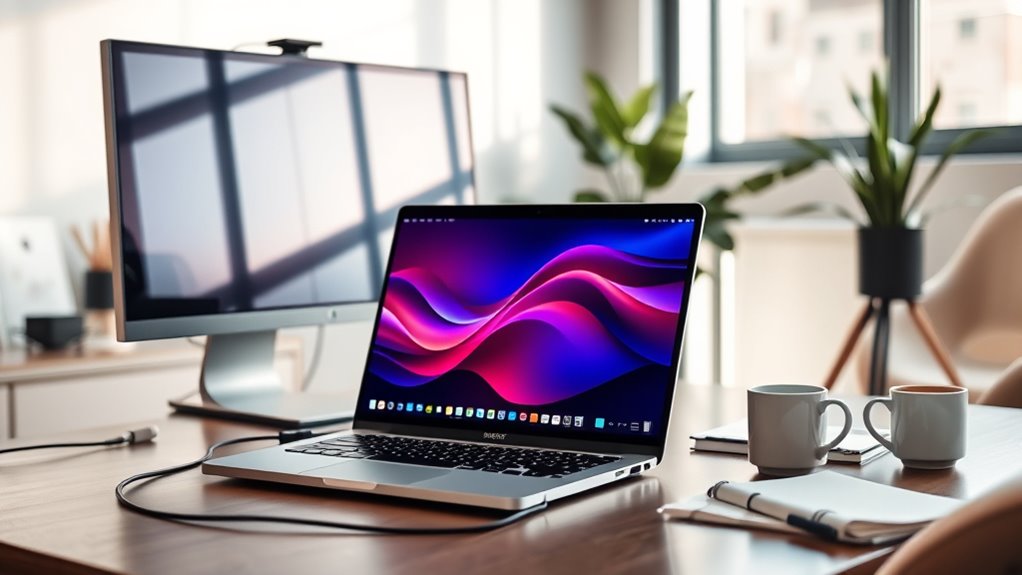Using your laptop as a monitor can really boost your productivity. First, check your devices for compatibility and gather the right cables or prepare for a wireless setup. For a wired connection, use HDMI or DisplayPort, and then adjust your display settings. If you prefer wireless, make sure both devices are on the same Wi-Fi and enable screen mirroring. If you run into issues, troubleshooting steps can help. You’ll discover more tips as you explore further.
Understanding the Benefits of Using a Laptop as a Monitor
Using a laptop as a monitor can be a game-changer for your workspace. By utilizing a dual display setup, you can greatly boost your productivity. Imagine having multiple applications open side by side, allowing you to multitask effortlessly. You can work on a document while researching online, or video conferencing while taking notes, all without constantly switching windows. This seamless integration fosters a more organized workflow and reduces distractions. Plus, it’s perfect for creative tasks, like graphic design, where you need to see your work from different angles. Embracing this setup not only enhances your efficiency but also gives you the freedom to customize your workspace to suit your unique needs. Explore the possibilities—your productivity will thank you!
Preparing Your Devices for Connection
To take full advantage of your laptop as a monitor, you’ll need to prepare both your laptop and the main device you want to connect it to. Start by checking device compatibility; verify your laptop supports the necessary input methods for the connection. Look into common connection methods like HDMI, USB-C, or wireless options, depending on your devices.
Next, update drivers and software on both devices to avoid any glitches during the connection. Clean your ports to guarantee a solid physical connection, if you’re using cables. Finally, have the correct cables handy, or be ready to set up wireless connectivity. By taking these steps, you’ll set yourself up for a seamless experience using your laptop as a monitor.
Setting Up a Wired Connection
Setting up a wired connection between your laptop and the device you want to use as a monitor is a straightforward process. First, identify the appropriate cable types for your devices, such as HDMI, DisplayPort, or VGA. Confirm both ends of the cable are securely connected to prevent any issues. Once connected, adjust your laptop’s display settings to extend or duplicate your screen. A wired connection offers enhanced connection stability compared to wireless options, reducing lag and improving image quality. This reliable setup allows you to enjoy your content seamlessly. Keep in mind that different cable types may support varying resolutions, so choose wisely to get the best experience possible. Now, you’re ready to enjoy your newly configured monitor setup!
Setting Up a Wireless Connection
While a wired connection offers stability, sometimes you may prefer the convenience of a wireless setup for using your laptop as a monitor. To start, verify both your laptop and the source device support wireless display technology. On your laptop, go to the display settings and select “Connect to a wireless display.” Your laptop will scan for available devices. Once you find your source device, click to connect. After pairing, you can enable screen mirroring to share your screen seamlessly. Make sure both devices are on the same Wi-Fi network for peak performance. With this setup, you can enjoy a clutter-free workspace while taking advantage of your laptop’s screen for various tasks, enhancing your productivity and freedom.
Troubleshooting Common Issues
Have you encountered issues while trying to use your laptop as a monitor? You aren’t alone; many face display resolution issues and connectivity problems. Here’s a quick guide to troubleshoot:
| Issue | Solution |
|---|---|
| Display Resolution Issues | Adjust settings in Display Options |
| Connectivity Problems | Check Wi-Fi and firewall settings |
| Lag or Delay | Reduce resolution or refresh rate |
| No Signal | Restart devices and reconnect |
Frequently Asked Questions
Can I Use Any Laptop as a Monitor?
Not every laptop’s compatible as a monitor. You’ll need to check for specific features and ports. Also, display quality varies, so verify the screen meets your needs for a satisfactory experience.
Will Using a Laptop as a Monitor Affect Its Performance?
Oh sure, using your laptop as a monitor won’t impact its performance… said no one ever! It’ll stress resource allocation, potentially slowing things down. But hey, who needs speed for freedom, right?
What Software Is Needed for Wireless Connections?
To connect wirelessly, you’ll need screen sharing or remote access software like TeamViewer, AnyDesk, or Chrome Remote Desktop. These tools let you seamlessly share your display and control your laptop from another device.
How Far Can the Devices Be From Each Other?
Your connection distance can vary, typically around 30 feet, depending on signal strength. Like a bird in flight, too far, and you risk losing that seamless connection. Keep devices within range for peak performance.
Is There a Way to Use Multiple Laptops as Monitors?
Yes, you can use multiple laptops as monitors through remote desktop applications or screen sharing. This allows you to access and control several devices simultaneously, giving you the flexibility to multitask effectively and efficiently.

